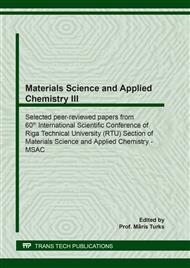[1]
M. Okmanis, I. Skranda, A. Lazdiņš, D. Lazdiņa, Impact of wood ash and potassium sulphate fertilization on growth of Norway spruce stand on organic soil, Research for rural development. 2 (2016) 62-68.
DOI: 10.17221/93/2015-jfs
Google Scholar
[2]
R. Siddique, Utilization of wood ash in concrete manufacturing, Resources, Conservation & Recycling. 67 (2012) 27-33.
DOI: 10.1016/j.resconrec.2012.07.004
Google Scholar
[3]
G. Goswami, B. Purohit, J. Arona, Fly ash waste management – a congenial approach, 2nd International conference on Innovative Trends in Science, Engineering and Management,. (2016) 181-183.
Google Scholar
[4]
F. Agrela, M. Cabrera, M.M. Morales, M. Zamorano, M. Alshaaer, Biomass fly ash and biomass bottom ash, New Trends in Eco-efficient and Recycled Concrete. 5 (2019) 23-58.
DOI: 10.1016/b978-0-08-102480-5.00002-6
Google Scholar
[5]
M. Okmanis, G. Petaja, A. Lupiķis, Productivity of mechanized wood ash application in forest, Research for rural development. 1 (2017) 62-68.
DOI: 10.22616/rrd.23.2017.009
Google Scholar
[6]
T.B. Andreasen, J. T. Nielsen, J. Voriskova, J. Heise, R. Rønn, R. Kjøller, H.C.B. Hansen, C.S. Jacobsen, Wood ash induced pH changes strongly affect soil bacterial numbers and community composition, Original research. 8 (2017) 1-14.
DOI: 10.3389/fmicb.2017.01400
Google Scholar
[7]
J. Pasanen, K. Louekari, J. Malm, Cadmium in wood ash used as fertilizer in forestry: risks to the environment and human health, Ministry of Agriculture and Forestry. (2001) 10-11.
Google Scholar
[8]
R.C.E. Modolo, T. Silva, L. Senff, L.A.C. Tarelho, Bottom ash from biomass combustion in BFB and its use in adhesive-mortals, Fuel Proc. Technol. 129 (2015) 192-202.
DOI: 10.1016/j.fuproc.2014.09.015
Google Scholar
[9]
P. Ochecova, P. Tlustos, J. Szakova, Wheat and Soil Response to Wood Fly Ash Application in Contaminated Soils, Agronomy, Soils & Environmental Quality. 3 (2014) 995-1002.
DOI: 10.2134/agronj13.0363
Google Scholar
[10]
A. Fuller, M. Stegmaier, N. Schulz, M. Menke, H. Schellhorn, F. Knödler, J.S. Maier, Use of wood dust fly ash from an industrial pulverized fuel facility for rendering, Construction and Building Materials. 189 (2018) 825-848.
DOI: 10.1016/j.conbuildmat.2018.09.016
Google Scholar
[11]
M. Kandziora-Ciupa, A. Nadgorska-Socha, G. Barczyk, R. Ciepal, Bioaccumulation of heavy metals and ecophysiological responses to heavy metal stress in selected populations of Vaccinium myrtillus L. and Vaccinium vitis-idaea L., Ecotoxicology. 7 (2017) 966-980.
DOI: 10.1007/s10646-017-1825-0
Google Scholar
[12]
M. Alberto, Characterization of wood combustion ashes, DTU. (2017) 9-15.
Google Scholar
[13]
P. Dróżdż, V. Šėžienė, K. Pyrzynska, Mineral Composition of Wild and Cultivated Blueberries, Biol. Trace Elem. Res. 1 (2018) 173-177.
DOI: 10.1007/s12011-017-1033-z
Google Scholar


